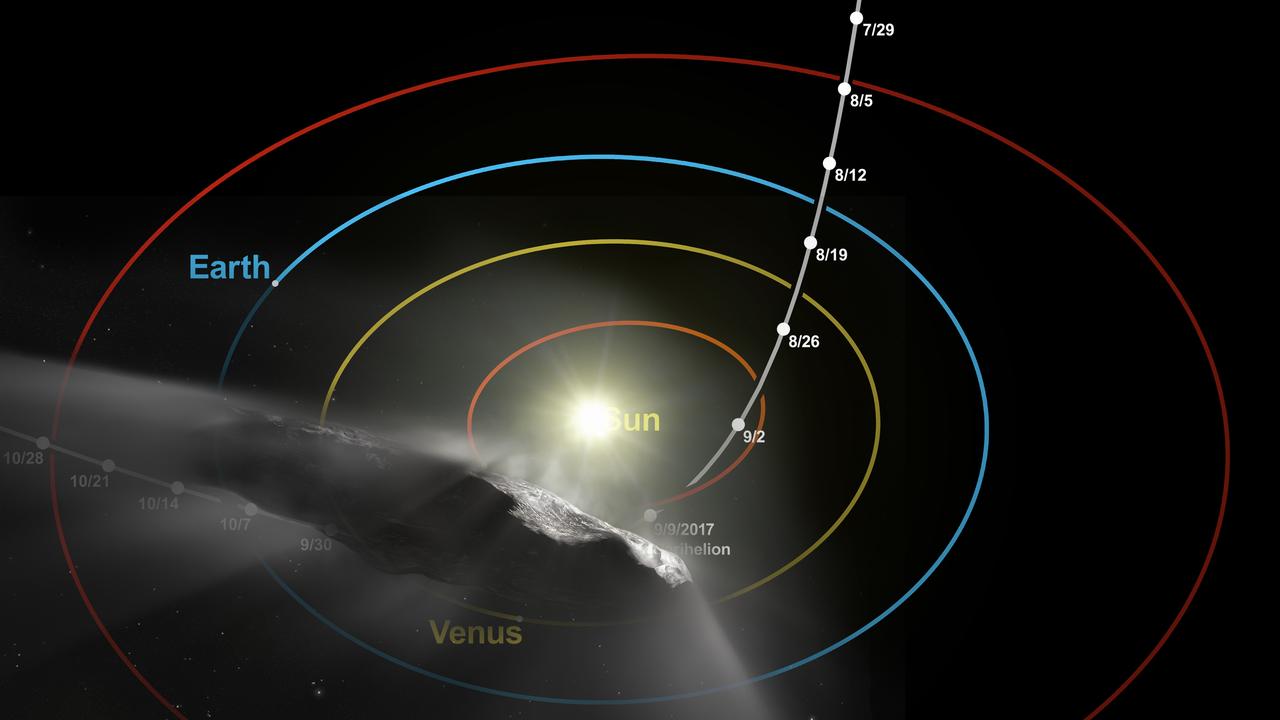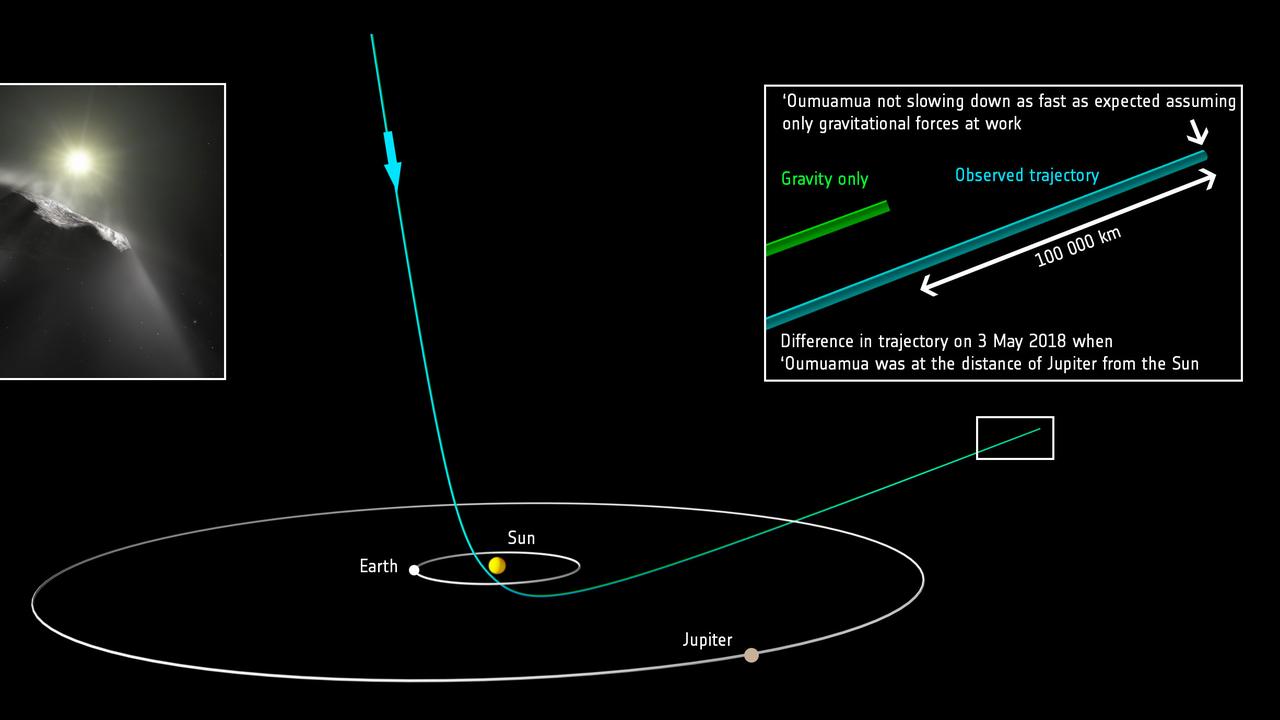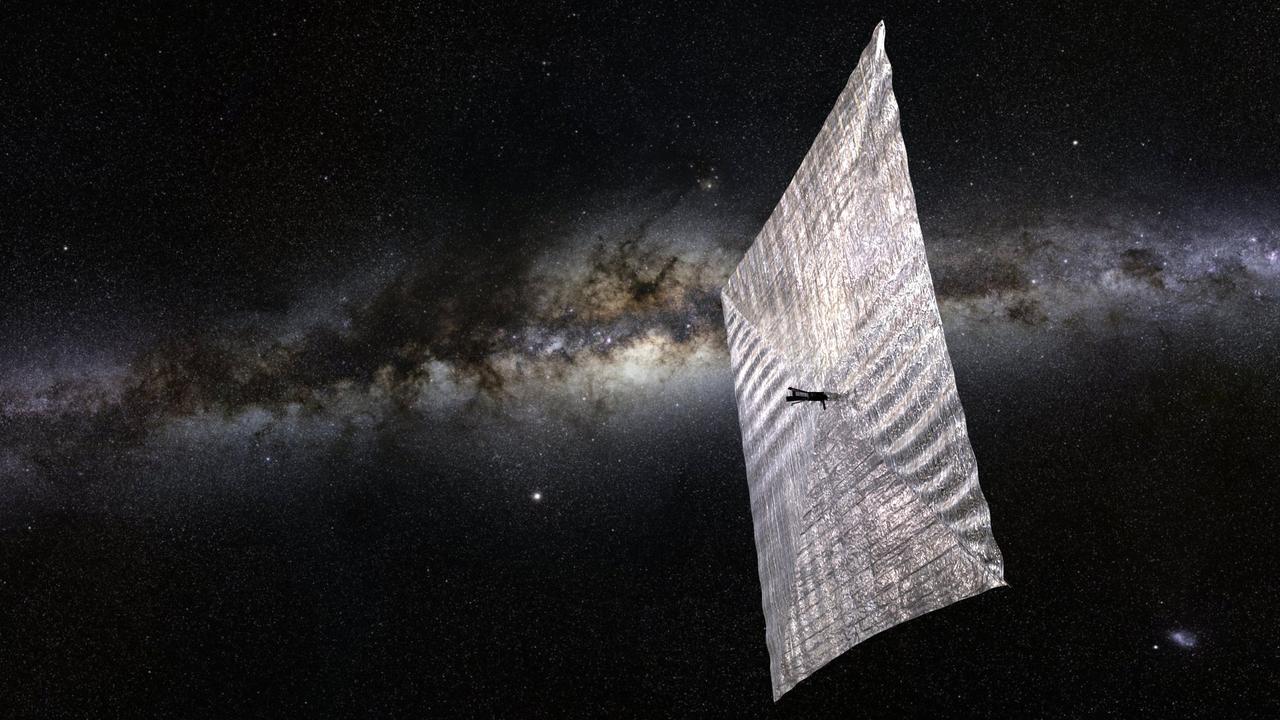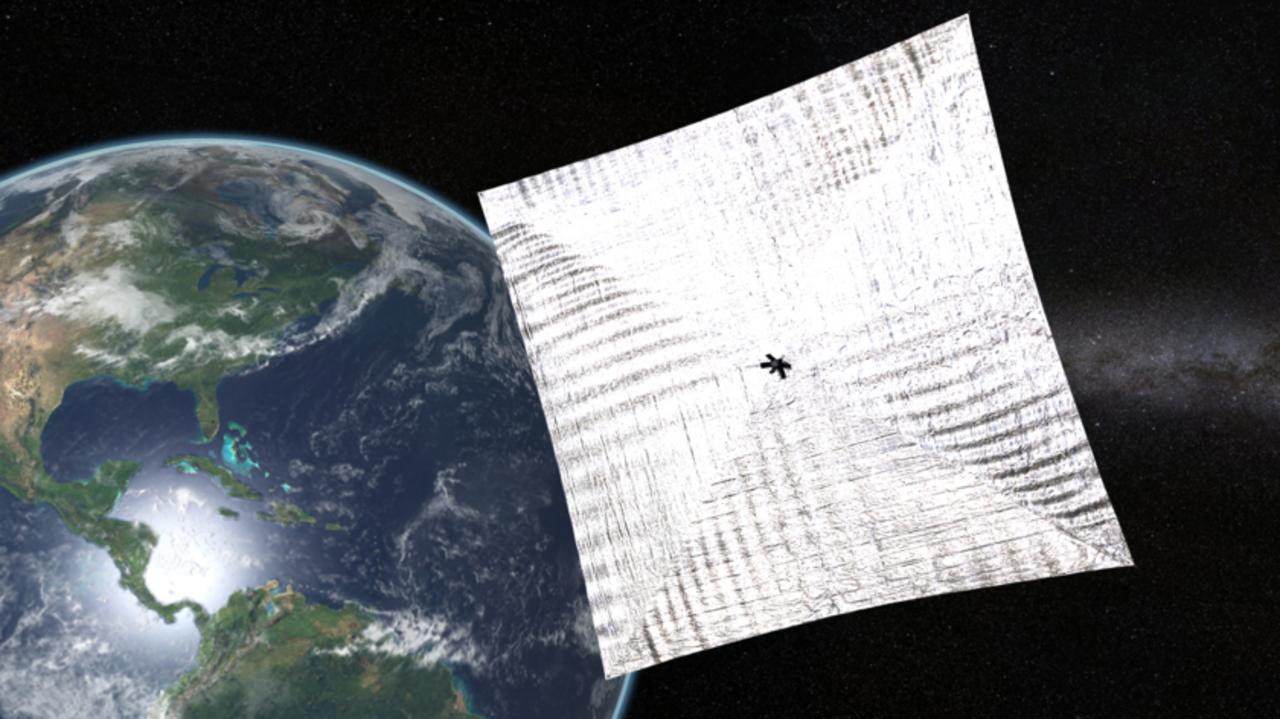‘Oumuamua: mysterious messenger from beyond the stars
The bizarre space object Oumuamua has scientists completely baffled. It’s possible we may have just missed first contact with aliens.
It may be an asteroid. It could be a comet. Perhaps it is … something else. But ever since humanity spotted it last year, I/2017 U1 ‘Oumuamua — the elongated chunk of something shiny spinning through our Solar System — has managed to give us the slip.
'Oumuamua means “scout” or “messenger” from the past, in Hawaiian.
It may be a very appropriate name.
There’s reason to suspect it could have an alien origin.
It’s behaving weirdly: flying through our Solar System on an open-ended parabola, proving it must have come from deep interstellar space.
Its eerie red hue is shinier than a typical comet.
It’s accelerating: admittedly by only a tiny amount, but something is giving 'Oumuamua a push. It could be comet-like ‘outgassing’. But at no point has the mysterious object been seen to have a comet’s tail.
It has a weird shape. Based on its erratic flashing, astronomers have inferred 'Oumuamua must be long and thin. Few known asteroids and comets are like that.
But … for it to be an alien artefact would be extraordinary.
And to prove that would require some extraordinary evidence.
However, our chances of learning anything more from our first known interstellar visitor are very slim. It’s racing away — back into deep space — at some 95,000km/h.
There are, however, other possible — and more probable — alternatives.
“I think we should look at the alien option given this asteroid is unusual, but while a more mundane explanation is reasonable it surely must be preferred,” says Monash University astronomer Michael Brown.

'OUMUAMUA MYSTERY
It was first spotted on October 19, 2017. It had approached our Sun from above. And that was the first clue.
It was an intruder.
It didn’t belong.
It wasn’t part of the swirling mass of gas, ice and rubble that had formed our Sun, planets, asteroids and comets.
It was only spotted once it came close enough to the Sun to reflect sufficient light to be detected by our instruments. It is believed to have entered the outreaches of our Solar System as far back as 1837.
And it was moving fast. Very fast.
Astronomers had very little time to react.
When NASA pointed its infra-red Spitzer Space Telescope towards 'Oumuamua in November 2017 last year, it saw … nothing.
Which is, in itself, telling.
“'Oumuamua was too faint for Spitzer to detect when it looked more than two months after the object’s closest approach to Earth in early September,” NASA says. “However, the “non-detection” puts a new limit on how large the strange object can be.”
Hubble had been able to watch it fade into the distance. It passed out of sight in January 2018.
By May 2018, 'Oumuamua was already racing past Jupiter. It’s expected to overtake Voyagers 1 and 2 in 2038 and cross the boundaries of our Solar System in 2196.
But what little we saw of 'Oumuamua tells us it was unusually bright.
When it was first seen plunging past the Sun, it did not have a tail — as comets do — caused by ice boiling off into space.
But, since then, the interstellar object has been noted to change course a little — and accelerate a little — as comets do.
Was the thrust generated by ice warmed by sunlight into an invisible ejected gas — from a weird concoction of interstellar substances, unlike anything we’ve ever seen?
Or is it an alien space probe operating under its own power, as one Harvard academic (himself a proponent of sending probes to nearby Proxima Centauri) suggests?

SHINING A NEW LIGHT
The NASA study suggests that 'Oumuamua may be up to 10 times more reflective than comets typically found in our solar system.
That is surprising.
But not as surprising as you may think.
Dr Brown says the object’s ‘brightness’ must be put in context as it doesn’t approach the scale necessary for a functional light sail.
“It’s shinier than a typical comet, but that’s saying it’s shinier than a lump of coal,” he says. “It could plausibly reflect 20 per cent of the light incident upon it, so it ain’t that shiny.”
Even so, how did it get buffed beyond normal?
“'Oumuamua had been travelling through interstellar space for millions of years, far from any star that could refresh its surface,” the NASA report states. “But it may have had its surface refreshed through ‘outgassing’ when it made an extremely close approach to our Sun, a little more than five weeks before it was discovered.”
Such ‘outgassing’ would have blasted away and grit on 'Oumuamua’s surface, and potentially allowed new deposits of highly reflective ice to harden in its place.
And this brightness may have caused 'Oumuamua to look bigger than it actually was to those optical telescopes that did manage to sight it, such as Hubble.
NASA now thinks it is less than half the original estimates of its size and is instead somewhere between 400m and 100m long.
“Usually, if we get a measurement from a comet that’s kind of weird, we go back and measure it again until we understand what we’re seeing,” said NASA’s Davide Farnocchia. “But this one is gone forever; we probably know as much about it as we’re ever going to know.”
NASA concludes that jets of gas from vents in the surface of 'Oumuamua have given it a slight boost in speed, as suggested earlier this year, even though this venting has not been observed.
The Spitzer Space Telescope — despite not seeing 'Oumuamua — reveals it is small enough for such acceleration to take place.
“That determination was dependent on 'Oumuamua being relatively smaller than typical solar system comets,” NASA states.
Several telescopes saw it was reflecting sunlight — but that it was varying dramatically. This suggested 'Oumuamua was elongated and less than 800m long.
Now, 'Oumuamua has passed. There’s nothing more we can do to observe it.
But there may be alternatives.
A new Harvard University study has used predictive computer models to analyse the orbits of objects orbiting between the Sun and Jupiter. Four of them ‘don’t fit’. Therefore, they also may have origins from outside our Solar System.

THE FOUR STRANGERS
There are four unusual wanderers in our Solar System. We don’t know much about them.
Objects 2011 SP25, 2017 RR2, 2017 SV13, and 2018 TL6 linger between the orbits of Jupiter and Neptune. But they do occasionally dip past Earth on their closest approach to the Sun.
A study published in the Monthly Notices of the Royal Astronomical Society was looking for anything that seemed out of place.
After crunching the probabilities, the researchers found that there should be at least 66 other interstellar objects, ranging in diameter from roughly 100 meters to 10 kilometres in size, captured in the Sun’s gravitational well.
“We find that there should be hundreds of 'Oumuamua-size interstellar objects identifiable by Centaur-like orbits,” the study reports. A Centaur a small body that orbits the Sun between Jupiter and Neptune, but cuts across the path of one or more of the giant planets.
“The Sun-Jupiter system acts as a fishing net that collects interstellar objects,” says Harvard University astrophysicist Professor Abraham Loeb. “ At any given time, there are a few thousand trapped objects within the solar system.”
So far, he and his team have identified four contenders.
But we have little chance of studying them for some time.
The first to swing back close to Earth will be 2018 TL6. It will make its closest approach in about 20 years.
“We do not know if they are comets, asteroids, or artefacts,” Harvard University astrophysics undergraduate Amir Siraj says. “(But) we do not have any evidence that these objects are unnatural at this point”.
Instead, he says they’re likely to be ejecta from the formation of distant solar systems.
Only a close observation will tell.
Are they abnormally shiny?
Are they abnormally shaped?
Are they making any sort of transmission?
Professor Loeb won’t rule out anything given what we know about Oumuamua: “These results are at odds with the properties of comets and asteroids in the solar system (and) are fully consistent with an artificial origin.”
But Dr Brown says most astronomers are far more cautious than Professor Loeb: “This is definitely an unusual object, but none of its observed properties are beyond the scope of natural asteroids and comets.”

PROBES PONDERED
Given how unusual Oumuama seems, it naturally drew the attention of the Search for Extraterrestrial Intelligence (SETI)
As part of the Breakthrough Listen initiative, SETI argued that if 'Oumuamua was an artefact it could potentially be emitting radio signals.
The SETI Institute used the Allen Telescope Array (ATA) to monitor the object for several weeks after it was first identified and situated some 274 million km away.
After sifting out background noise, the powerful radio telescope revealed the object hadn’t emitted a peep.
No interstellar broadcast was heard. No probing radar was detected.
“We were looking for a signal that would prove that this object incorporates some technology — that it was of artificial origin,” says researcher Gerry Harp. “We didn’t find any such emissions, despite a quite sensitive search. While our observations don’t conclusively rule out a non-natural origin for ‘Oumuamua, they constitute important data in accessing its likely makeup.”
So the chances of it being an interstellar space probe have taken a dive. Or, at least of it being a functional one.
But SETI still holds out hope.
It’s interested in other, strange objects in our Solar System.
“It has been long-hypothesised that some of the latter could be interstellar probes, and radio observations offer a way to address this imaginative, but by no means impossible, idea,” it says in a statement.
And attempts to figure out where Oumuama came from have failed to find a likely contender. Astronomers found four potential candidates after backtracking along its known flight trajectory. But given their relative motions, these stars are highly unlikely to have spat such an object out at such an angle, and so fast.
So they’re resigned to waiting for the Gaia Space Telescope to continue its survey of space and hope it will throw up further possibilities.

TO BE, OR NOT TO BE?
All these findings do nothing to confirm — or outright deny — the recent controversial claims by two Harvard researchers, Shmuel Bialy and Professor Loeb.
“A more exotic scenario is that 'Oumuamua may be a fully operational probe sent intentionally to Earth vicinity by an alien civilisation,” they wrote.
But this was pure speculation, based solely on the object’s surprising speed and course.
That it was so reflective could, however, add fuel to the ‘alien space probe’ idea. Light sails work in a similar way wind sails do — harnessing the energy of solar winds by reflecting them in another direction to generate thrust.
And the smaller size calculated by the Spitzer observation is also an argument space probe proponents will dismiss: the Harvard professors are themselves advocating ‘star chips’ — tiny solar-sail propelled probes — be launched at nearby stars.
Curtin University’s Professor of radio astronomy, Steven Tingay, says the reaction among his fellow scientists to this idea has been surprising.
“On social media, there have been some pretty personal attacks by scientists — on Loeb in particular — for being in the media for this work,” he writes in The Conversation.
“No scientist has claimed 'Oumuamua is alien in this discussion — they have just raised questions and explored answers. There is no point in shying away from a proper discussion on the search for extraterrestrial intelligence, or in being personally critical of colleagues … If aliens are claimed, direct and robust evidence is required — not a conclusion based on a few observations that are difficult to explain, plus a bunch of assumptions.”
What has been seen makes it most likely that 'Oumuamua is, in fact, a dirty interstellar comet, crusted by deposits and turned red by thousands of years of exposure to cosmic rays in interstellar space. Once close enough to the Sun to boil this away, the shiny inner core was exposed — changing its characteristics in such a way as to alter its orbit.
We’ll never know for sure, though.
There is no way to get a good look at the rapidly retreating enigma.
But we likely have not heard the end of it yet.
“Whatever 'Oumuamua is (almost certainly not made by aliens, in my view), it is a fascinating object and presents lots of interesting scientific questions that will trigger further studies and observations,” Professor Tingay says.



